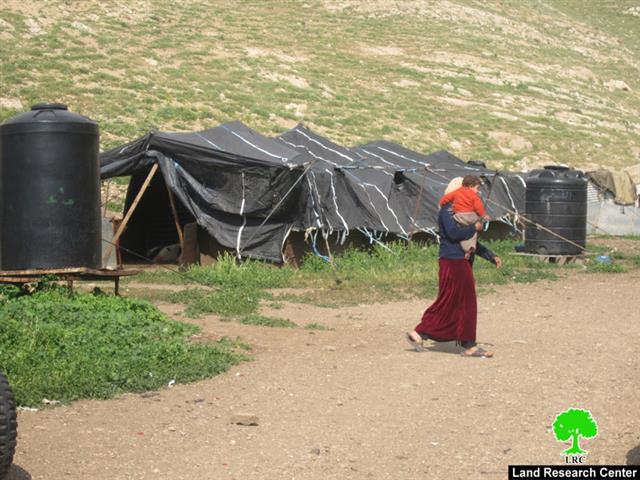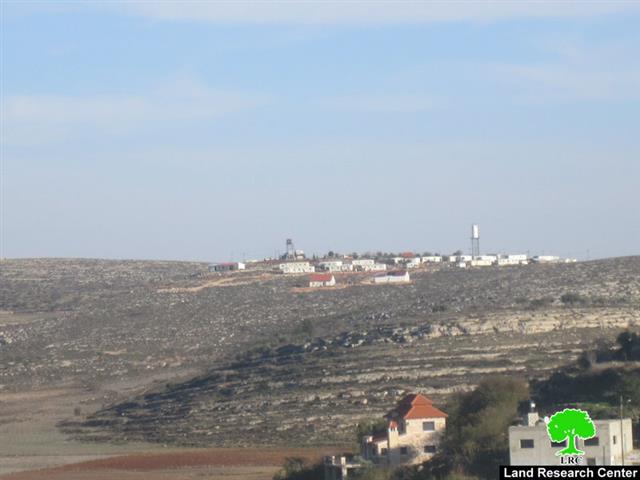Violation: the occupations serves demolition orders on structure
Date: 22/12/2013
Location: Khirbet al-Farisya
Perpetrators: Inspection Sub-Committee of the Civil Administration
Victims: 3 Bedouin families( 17 members including 7 minors)
Details:
On December 12th 2013, the so-called Inspection Sub-Committee of the Civil Administration served three demolition orders on residential and agricultural structures located in the middle of the Palestinian Jordan Valley. The orders gave the residents a deadline not longer than a week from the date of issuance.
The Civil Administration justified the demolition under the pretext of unlicensed construction within area classified C according to Oslo Accord, taking into consideration that the Inspection Sub-Committee served the residents stop work orders on August 21th. The following table shows information about the notified structures:
|
Affected citizen |
Family |
Minors |
Structures notified with demolition |
No. of the military order |
|
|
Tent |
Barn |
||||
|
Ali Abu Mohsen |
9 |
5 |
2 |
2 |
391088 |
|
Hassan Mohsen |
5 |
2 |
1 |
2 |
391087 |
|
Hussien Daraghmih |
3 |
0 |
1 |
1 |
391086 |
|
|
17 |
7 |
4 |
5 |
|
It should be mentioned that the Khirbet is located 20km away from northeast Tubas. The lands of al-Farisya ranges between west of the area of al-Tayasir to east of Jordan River. It has a total population of 400 people, knowing that their numbers before the occupation of 1967 exceeded a thousand people who fully depended on field crops plantation and livestock husbandry. This means that the Khirbet population should be more than 6000 people unless the occupation didn’t harass and limit them in terms of building and planting t, which caused them to shrink to only 400 people.
The Khirbet's main families are Dababat and Daraghmih who had roots in Tubas, the village of Tammun and some parts of south Hebron, more specifically Yatta town. Citizens of the area reside in houses( built by metal slabs) and tents, which did not survive the violations of the occupation represented in evection orders under the pretext of unlicensed construction within a closed military zone.
It should be marked that the authorities of the occupation worked hard to annex and Judaize the area of al-ghoor " Palestinian Jordan Valley" claiming it the eastern defense line for their state. Another reason behind Israel's interest in the area is the area's importance as a water basin that supply their needs. This is the reason why the occupation confiscated most of the agricultural lands in Wadi al-Maleh, east of Tubas and the water springs that were transferred into military facilities and inaccessible areas for Palestinians in addition to building random colonies in the nearby for sake surrounding al-Farisya. For example, the vast colonies of Rotem and Mehola which expropriated more than 700dunum from the lands of Khirbet al-Farisya.
Not only that, the occupation planted the eastern lands of the Khirbet with mines besides transferring the mountains tops into military bases and camps for special training. This has badly affected the commercial status of farmers in a way the percentage of Wadi al-Maleh lands allowed to be used by Palestinian shrank to 1%. Agriculture and livestock husbandry were also affected after declaring mountains inaccessible for Palestinians claiming it closed military zone. As a result, most the residents fled the area where only 5 out of 75 families remained in the area.
Land Research Center LRC sees that the demolitions contradict with all the International conventions and Humanitarian laws including:
Article 53 of the Geneva Fourth Convention (1948) declaring: “Any destruction by the Occupying Power of real or personal property belonging individually or collectively to private persons, or to the State, or to other public authorities, or to social or cooperative organizations, is prohibited, except where such destruction is rendered absolutely necessary by military operations.”
Prepared by
The Land Research Center
LRC















